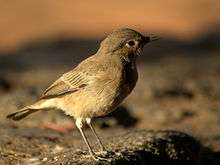Familiar chat
| Familiar chat | |
|---|---|
 | |
| Scientific classification | |
| Kingdom: | Animalia |
| Phylum: | Chordata |
| Class: | Aves |
| Order: | Passeriformes |
| Family: | Muscicapidae |
| Genus: | Cercomela |
| Species: | C. familiaris |
| Binomial name | |
| Cercomela familiaris (Wilkes, 1817) | |
| Synonyms | |
|
Oenanthe familiaris | |
The familiar chat, Cercomela familiaris, is a small passerine bird of the Old World flycatcher family Muscicapidae. It is a common resident breeder in Africa south of the Sahara in rocky and mountainous habitat and around human habitation.
Taxonomy
The familiar chat is included in the genus Cercomela. Molecular phylogenetic studies published in 2010 and 2012 found that the genus Cercomela was polyphyletic with five species, including the familiar chat, phylogenetically nested within the genus Oenanthe, however many taxonomists continue to place the bird in Cercomela.[2][3] As part of a reorganization of the species to create monotypic genera, the familiar chat was assigned to the genus Oenanthe.[4]
Description
The familiar chat is a dumpy short-tailed bird 14–15 cm long. The adult’s upperparts are dark brown, and the face sides behind the eye are orange. The underparts vary from off-white to pale grey-brown, and the rump and outer tail feathers are orange. The central tail feathers are dark brown. The short straight bill and the legs and feet are black. The sexes are similar, but the juvenile is dark brown above and buff below, heavily marked with buff on the upperparts, and scaly on the breast.
The familiar chat has a soft "shek-shek" alarm call. The song is a warbling trill.
Behaviour
The familiar chat builds a cup-shaped nest of hair, wool, feathers or soft plant material on a base of coarse vegetation. It is constructed in a hole in the ground, a rock face or building. It will use nest boxes or a disused sociable weaver nest. It normally nests from July to April, but will breed at any time when conditions are right, especially in the more arid areas.
The familiar chat is typically seen sitting on a rock, or hopping on bare patches of soil. It has a habit of flicking its wings once or twice every time it moves. It is seen in small family groups of up to five birds, and is invariably tame and approachable. It eats insects, fruit, animal fat and household or farmyard scraps.
The Afrikaans name for this species "spekvreter" means "fat-eater", and comes from the fact that it developed the habit of feeding on the lard used to grease wagon axles by the voortrekkers.
References
- ↑ BirdLife International (2012). "Cercomela familiaris". IUCN Red List of Threatened Species. Version 2013.2. International Union for Conservation of Nature. Retrieved 26 November 2013.
- ↑ Outlaw, R.K.; Voelker, G.; Bowie, R.C.K. (2010). "Shall we chat? Evolutionary relationships in the genus Cercomela (Muscicapidae) and its relation to Oenanthe reveals extensive polyphyly among chats distributed in Africa, India and the Palearctic". Molecular Phylogenetics and Evolution. 55 (1): 284–292. doi:10.1016/j.ympev.2009.09.023.
- ↑ Aliabadian, M.; Kaboli, M.; Förschler, M.I.; Nijman, V.; Chamani, A.; Tillier, A.; Prodon, R.; Pasquet, E.; Ericson, P.G.P.; Zuccon, D. (2012). "Convergent evolution of morphological and ecological traits in the open-habitat chat complex (Aves, Muscicapidae: Saxicolinae)". Molecular Phylogenetics and Evolution. 65 (1): 35–45. doi:10.1016/j.ympev.2012.05.011.
- ↑ Gill, Frank; Donsker, David, eds. (2016). "Chats, Old World flycatchers". World Bird List Version 6.2. International Ornithologists' Union. Retrieved 20 May 2016.
- Ian Sinclair, Phil Hockey and Warwick Tarboton, SASOL Birds of Southern Africa (Struik 2002) ISBN 1-86872-721-1
- SASOL e-guide
External links
- Familiar chat - Species text in The Atlas of Southern African Birds.
